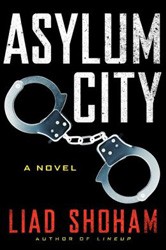Scan the pages of In a DarkWood, by Marcel Möring, a Dutch author, and you will realize at once that this novel demands review in terms of form as well as content. Marcel Möring uses graphics, word play, and typographical manipulation designed to stimulate and call attention to visual sound; in addition, this novel contains the merging of language perhaps designed to draw attention to key points, for example, “fromwhenwewerestillyoungandtheworldwasgood,” but also to invite the reader to slow down, separate, deconstruct, and then ponder each statement. And then, there are eight unnumbered pages of a comic strip nestled between pages on which only a closed parenthesis appears and one that contains concentric circles, only. Later on, the reader finds a graphic of the word “splat” and then a page devoted to words in various fonts and sizes. One wonders why these visual strategies need be included in a novel so artfully written, first in free verse, and then as a narrative — that is, until the tale is told in its entirety. That’s when they all seem to fit, and the visual noise resonates.

In a Dark Wood
Discussion Questions
1. What do you think Möring used as his inspiration for this book?
2. What are the novel’s key themes? How does Möring express such themes?
3. How does Marcus help Jacob Noah reconcile the implications of his Jewish identity and understand his experiences from World War II?
4. What is the significance of Assen as the book’s setting?
5. In a Dark Wood addresses questions of guilt that are common among survivors of the Holocaust. How do Jacob Noah and Marcus attempt to reconcile their feelings of guilt? What do they do differently? Do you think either of them succeeds?
6. The Dutch title of the book is “Dis,” the permanent posthumous home for all types of sinners referred to in Dante’s Inferno. Do you think that the English translation should have kept the same title? Which title do you think serves the book better?
7. Are the book’s central themes — guilt, fear, loss, and salvation— particular to a post World War II Germany and the uniqueness of the Holocaust? Is there any parallel to it in the American experience?
8. How does this novel leave you feeling and thinking? Is it hopeful or ultimately despairing? If you have read other Holocaust literature, how does In a Dark Wood compare?

Help support the Jewish Book Council.



